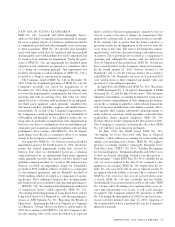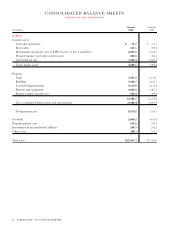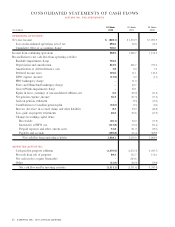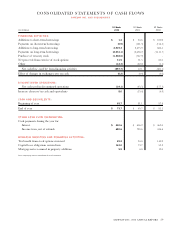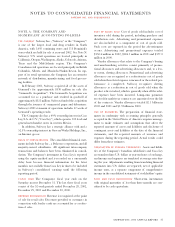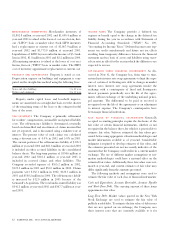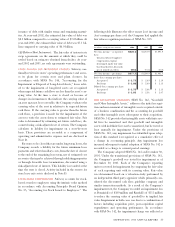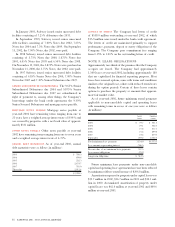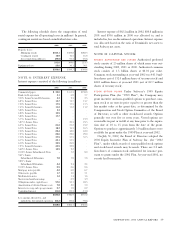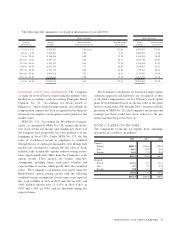Safeway 2002 Annual Report Download - page 34
Download and view the complete annual report
Please find page 34 of the 2002 Safeway annual report below. You can navigate through the pages in the report by either clicking on the pages listed below, or by using the keyword search tool below to find specific information within the annual report.
32 SAFEWAY INC. 2002 ANNUAL REPORT
MERCHANDISE INVENTORIES Merchandise inventory of
$1,802.8 million at year-end 2002 and $1,690.4 million at
year-end 2001 is valued at the lower of cost on a last-in, first-
out (“LIFO”) basis or market value. Such LIFO inventory
had a replacement or current cost of $1,867.9 million at
year-end 2002 and $1,773.0 million at year-end 2001.
Liquidations of LIFO layers resulted in income of $5.3 mil-
lion in 2002, $1.8 million in 2001 and $2.2 million in 2000.
All remaining inventory is valued at the lower of cost on a
first-in, first-out (“FIFO”) basis or market value. The FIFO
cost of inventory approximates replacement or current cost.
PROPERTY AND DEPRECIATION Property is stated at cost.
Depreciation expense on buildings and equipment is com-
puted on the straight-line method using the following lives:
Stores and other buildings 7 to 40 years
Fixtures and equipment 3 to 15 years
Property under capital leases and leasehold improve-
ments are amortized on a straight-line basis over the shorter
of the remaining terms of the lease or the estimated useful
lives of the assets.
SELF-INSURANCE The Company is primarily self-insured
for workers’ compensation, automobile and general liability
costs. The self-insurance liability is determined actuarially,
based on claims filed and an estimate of claims incurred but
not yet reported, and is discounted using a risk-free rate of
interest. The present value of such claims was calculated
using a discount rate of 4.0% in 2002 and 5.0% in 2001.
The current portion of the self-insurance liability of $105.3
million at year-end 2002 and $85.6 million at year-end 2001
is included in other accrued liabilities in the consolidated
balance sheets. The long-term portion of $194.6 million at
year-end 2002 and $181.2 million at year-end 2001 is
included in accrued claims and other liabilities. The
Company recorded expense of $165.2 million in 2002,
$121.5 million in 2001 and $55.0 million in 2000. Claims
payments were $132.1 million in 2002, $120.1 million in
2001 and $108.2 million in 2000. The self-insurance liabili-
ty increased by $12.0 million in 2001 because of the
Genuardi’s Acquisition. The total undiscounted liability was
$341.5 million at year-end 2002 and $307.7 million at year-
end 2001.
INCOME TAXES The Company provides a deferred tax
expense or benefit equal to the change in the deferred tax
liability during the year in accordance with Statement of
Financial Accounting Standards (“SFAS”) No. 109,
“Accounting for Income Taxes.” Deferred income taxes rep-
resent tax credit carryforwards and future net tax effects
resulting from temporary differences between the financial
statement and tax basis of assets and liabilities using enact-
ed tax rates in effect for the year in which the differences are
expected to reverse.
OFF-BALANCE SHEET FINANCIAL INSTRUMENTS As dis-
cussed in Note G, the Company has, from time to time,
entered into interest rate swap agreements to limit the expo-
sure of certain of its floating-rate debt to changes in market
interest rates. Interest rate swap agreements involve the
exchange with a counterparty of fixed and floating-rate
interest payments periodically over the life of the agree-
ments without exchange of the underlying notional princi-
pal amounts. The differential to be paid or received is
recognized over the life of the agreements as an adjustment
to interest expense. The Company’s counterparties have
been major financial institutions.
FAIR VALUE OF FINANCIAL INSTRUMENTS Generally
accepted accounting principles require the disclosure of the
fair value of certain financial instruments, whether or not
recognized in the balance sheet, for which it is practicable to
estimate fair value. Safeway estimated the fair values pre-
sented below using appropriate valuation methodologies and
market information available as of year-end. Considerable
judgment is required to develop estimates of fair value, and
the estimates presented are not necessarily indicative of the
amounts that the Company could realize in a current market
exchange. The use of different market assumptions or esti-
mation methodologies could have a material effect on the
estimated fair values. Additionally, these fair values were esti-
mated at year-end, and current estimates of fair value may
differ significantly from the amounts presented.
The following methods and assumptions were used to
estimate the fair value of each class of financial instruments:
Cash and Equivalents, Accounts Receivable, Accounts Payable
and Short-Term Debt. The carrying amount of these items
approximates fair value.
Long-Term Debt. Market values quoted on the New York
Stock Exchange are used to estimate the fair value of
publicly traded debt. To estimate the fair value of debt issues
that are not quoted on an exchange, the Company uses
those interest rates that are currently available to it for



